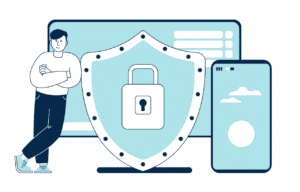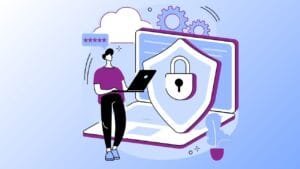In the age of artificial intelligence, maintaining digital privacy has become more challenging than you might think. The advancements in AI have transformed the dark web landscape, particularly in terms of people’s personal information. Today, the risks are greater than ever!
In 2022, Doxbin, a vulnerable website that hosted a variety of papers containing people’s personal information, was leaked. Can you imagine your personal address, contact details, and even your social security number all being exposed on the web? This is exactly what happened.
We will be discussing it in-depth soon. But before that, let’s learn what Doxbin is, how Doxbin operates, what doxing is, the role of AI in doxing, rules and regulations, the Doxbin data breach, the impact of data breaches on personal information and security, and some commonly asked questions.
What is Doxbin (Darknet)?
Doxbin is a paste website where people can share their personal details or personal identifiable information (PII). These can include name, address, social security numbers, license details, and others. Doxbin’s presence today displays the legal and ethical challenges of balancing privacy and accountability.
Since it is a dark web platform where extremely personal information keeps floating around, Doxbin is a breeding ground for identity theft, online harassment, etc. This is especially prevalent with the introduction of AI, as artificial intelligence supercharges doxing methods.
Before understanding what doxing is, let us understand
How AI is Transforming Doxbin?

In 2025, AI tools are proving highly effective for cybercriminals. These tools allow them to collect, analyze, and negatively utilize the personal information of thousands of people. Previously, Doxbin users could only rely on manual efforts to manage and compile data, but with AI:
- Data scraping is automated. AI enables PII extraction from publicly available resources at a massive scale.
- Social engineering can be scaled easily. Users can efficiently create personalized phishing emails or impersonation attacks.
- AI can be used to find out potential vulnerabilities in victims for predictive targeting.
Even after being shut down several times, Doxbin is still notoriously functional. Users utilize platforms like Telegram to regroup, plan, and remain undetected by officials. This ongoing loop displays the complexities of handling activities on the dark web. This was already a challenge, now more so due to the advent of AI.
Related: SMB Guide to Cloud Security and Cyber Threats
How Does Doxbin Operate?
Users rely on tools like Tor, which guarantees privacy and security without coming under the radar. Besides Tor, they also use the Internet. When it comes to sites like Doxbin, privacy is a vital aspect: both for the users uploading their personal information and for people viewing this information. Anonymity allows users to guard their identity and location.
On the Doxbin website, users can view information from multiple categories, like:
1. Personal Information
In this case, people should mention PII, like names, addresses, contact details, social security numbers, and others.
2. Legal Documents
This category displays legal documents related to paralegal offices’ cases, for example, court records and lawsuit forms.
3. Financial Documents
Users upload details like bank account information, credit card details, bank statements, transaction histories, etc.
4. Specific Datasets
With Doxbin, users can have access to documents of specific organizations and groups. Even to multiple files with various kinds of personal information.
Users can get specific information by using targeted keywords or browse among categories to locate the required documents.
What’s Doxing? With Examples
The act of publicly publishing personal identifiable information, PII, of people without their consent is called doxing. These PII consist of sensitive information like name, home/ work address, financial details, bank account information, etc. Doxing is mainly used with harmful intent, like personal harm, online harassment, targeted crimes, intimidation, and other such malicious activities.
In the 1990s, the term ‘doxing’ came into practice in the hacker world. In this case, anonymity is considered the most valuable aspect. Often, hackers would ‘drop docs’ documents on an enemy to reveal their true identity. Ever since the advent of social media platforms, doxing has made its way to the real world from the hacker community.
Let’s understand the significance of the term with some examples.
Doxing Examples:
- Today, your social media account can be hacked, and all your personal information can be shared with the world in an instant.
- Hackers can also use your domain registration information to get your address details.
These examples show how doxing can harm people in ways like identity theft, information leaks, threats, etc.
Also Read: Top 5 Market Intelligence Platforms for B2B Success
The Role of AI in Modern-Day Doxing
Just like most technology, AI in doxing has led to the evolution of tactics. As I have already discussed earlier, traditional methods needed manual intervention. Whereas with AI, hackers can be faster, more efficient, and scale more easily.

Let’s learn about some of the key developments of AI in doxing:
- AI enhances data aggregation massively. It can go through huge datasets, including leaked information on Doxbin, compile user profiles, all within a few minutes. AI can also track IP addresses of doxers, use social engineering to disclose physical addresses, and collect more data.
- AI can also drive social engineering on social media accounts. AI tools can analyze behavioral patterns and online activity to create phishing messages or impersonations that are highly convincing. This can be particularly harmful for small to medium businesses, in which employees can unknowingly reveal sensitive business information.
- Previously, Doxbin was used to target individual victims. With AI, attackers today can massively scale their operations. One AI tool can be used to scrub several platforms at once, get information, and deploy attacks at a huge scale.
Rules & Regulations Surrounding Doxbin
Concerns Regarding Privacy & Security
Doxbin is a dark force against people’s right to privacy and safety. Hackers can use platforms like this to distribute extremely private information without consent to cause havoc. These can include personal threats, financial fraud, identity theft, and many other scary acts. Once your personal information is up on the web, there’s almost no chance of a complete clean-up.
Ethical & Legal Problems
Platforms like Doxbin always possess a trail of ethical and legal dilemmas. Most regions consider Doxbin’s use illegal. This is because acquiring personal information without consent is considered a part of criminal offense. People involved in such activities can also face severe criminal charges.
As per Doxbin’s privacy policy, Section 230 of the United States Communications Decency Act offers legal immunity to the operators against legal threats involving any information uploaded to the website.
Consequences on Businesses
Many businesses are exposed to threats from sites like Doxbin. As days pass, data breaches and leaks are becoming more common. This comprises the most sensitive information of business institutions, resulting in financial loss, defamation, and even legal issues. At times, businesses holding sensitive customer information can be majorly targeted.
Challenging For Law Protectors
Police institutions can face severe challenges from platforms like Doxbin. In case of consequences, pinpointing the attacker can become a task, as anonymity protects their identity. Since the internet is a global phenomenon, specifying a jurisdiction and applying laws can be problematic.
How Can We Manage Doxbin-Related Challenges?
To manage these issues, people must consider a multi-tiered strategy, involving technology, legislation, and awareness.
1. Technological Solution: As I have mentioned multiple times in my blogs before, technology can be used to cut technology. How? By using better encryption, enhanced security, and applying stricter authentication methods, organizations can protect their data from leaks and breaches.
2. Legislative Solution: Doxbin functions by identifying the loopholes in the legislative systems. It might be operational by violating multiple existing laws. Authorities need to keep an eye out for these loopholes and develop ways to prevent platforms like these from operating unhesitatingly. Deeds like data/ PII leaks should come with heavy financial penalties.
3. Education Solution: To keep a check on the harmful consequences of Doxbin, people and businesses need to be aware of sharing information online. They should understand what to share, how much to share, and most importantly, what not to share. Raising awareness is a vital step towards curbing privacy and cybersecurity issues in the future.
Related: What Is Paid Search Intelligence? Know All About It
The Famous Doxbin Data Breach
The most famous Doxbin data breach took place on 5 January 2022. A cybercriminal shared the PII from Doxbin to an external forum. This exposed a massive amount of data, approximately. 41000 user credentials, from usernames and passwords to email addresses.
The volume of the exposed data was huge, almost 300,000 Doxbin’s registered users were affected, though the exact number is still unknown. This leak displayed the poor infrastructural strength of platforms like Doxbins and the associated risks that come with storing information on them.
Impact of Data Breaches on Personal Information & Security

Leaked information on Doxbin severely threatens the sole existence of an individual or organization. As the saying goes, “Once on the internet, always on the internet.” Information like names, addresses, bank account details, etc., once on the web, cannot be easily controlled.
They can often persist on cached pages. The consequences of these situations can be:
- Business Risks: When sensitive organizational data, including customer information, is leaked, the organization can face reputational damage, legal issues, and financial losses.
- Identity Theft: Scamsters can use stolen personal data to open a fraudulent account or get access to financial records.
- Swatting: AI-powered malicious reports can easily become threatening encounters with law enforcement.
Doxbin: Some Frequently Asked Questions (FAQs)
Q1. Is Doxbin illegal?
As of 2024, Doxbin’s terms of service restrict users from posting third-party links to underage explicit images, personal information specifically about children under 15, or direct threats of physical harm, terroristic threats, and swat threats
Q2. Is it easy to get doxed?
If you post too much personal information online or do not follow cybersecurity best practices, you can easily be a victim of doxing.
Q3. Am I safe from doxing?
Anyone can be a target of doxing online. To prevent it from happening or reduce the risk, you can limit sharing personal information online, choose strong passwords, change them regularly, and configure the privacy settings of your social media accounts.
Q4. Can minors be doxed?
Minors are more likely to be victims of doxing as they tend to post too much online without understanding the associated risks. They can face harassment and online bullying. In the case of children, parents must be proactive in monitoring their online activities and instilling cybersecurity awareness among them.
Q5. How do I know whether I’ve been doxed or not?
To know whether you have been doxed or not, search your name online, check your social media channels for strange activities, and see whether you receive any unknown calls or messages. These activities can indicate that your personal information is disclosed through doxing.
Related: 50 Years of Artificial Intelligence: From Imagination to Innovation






